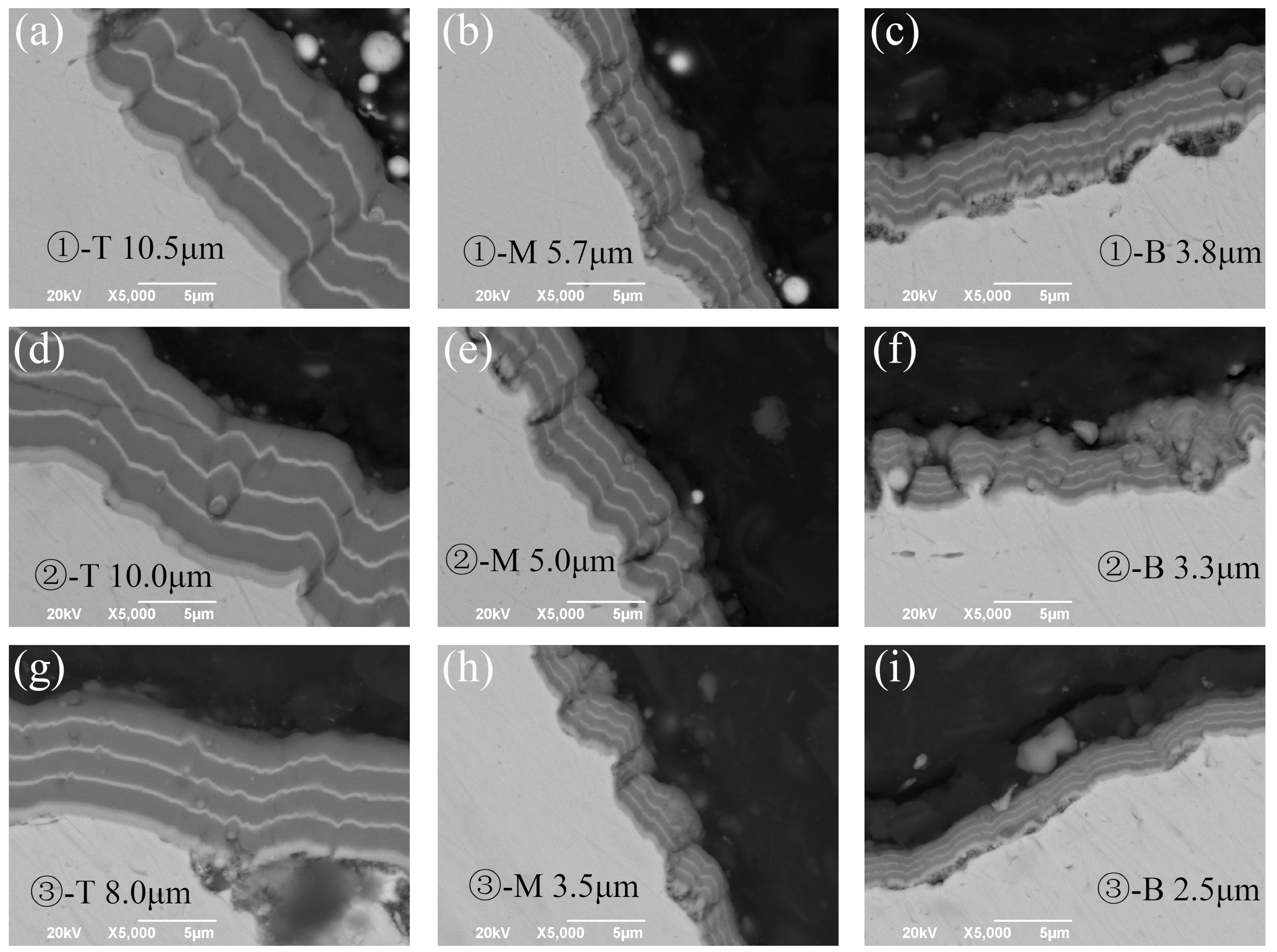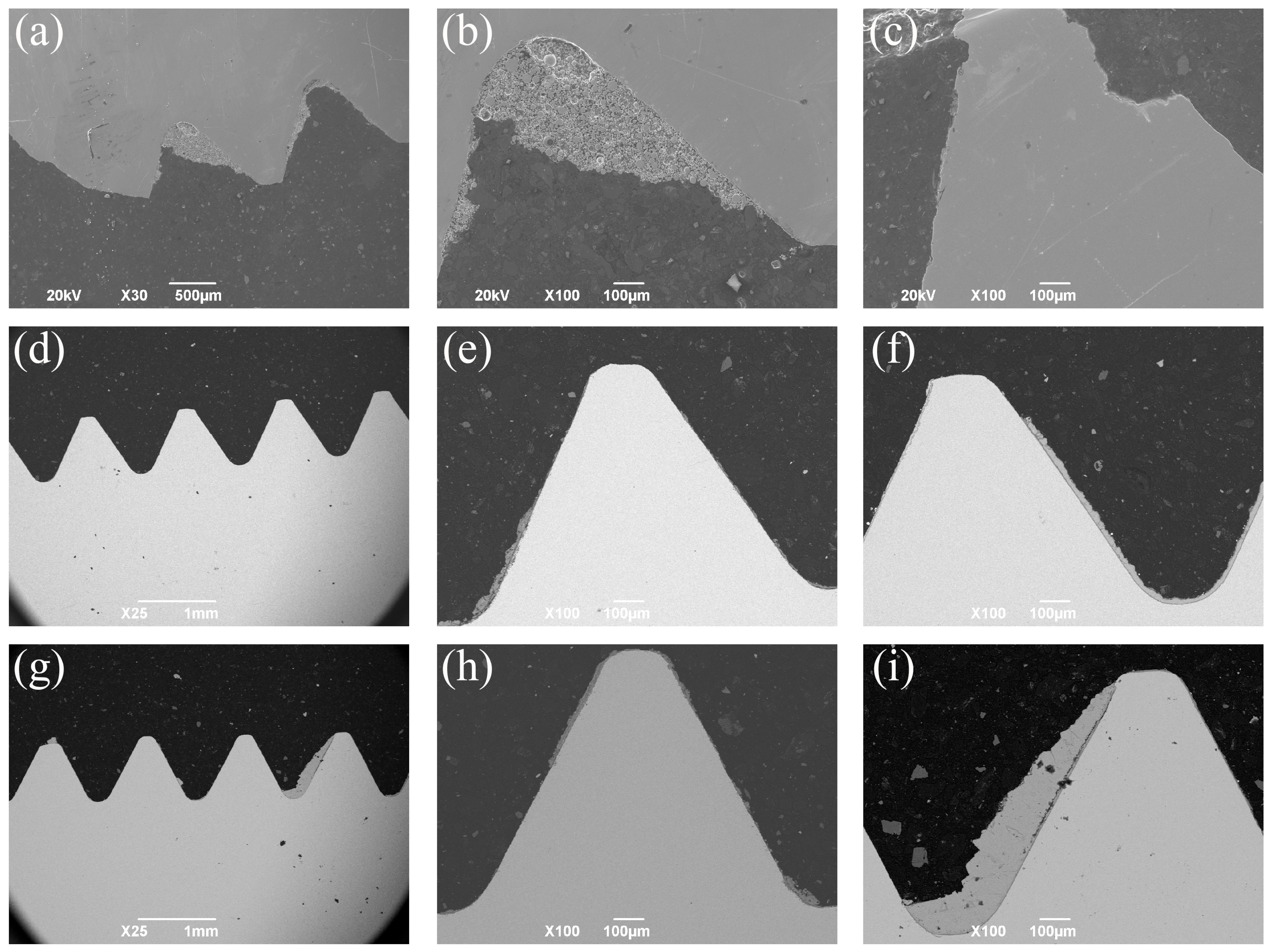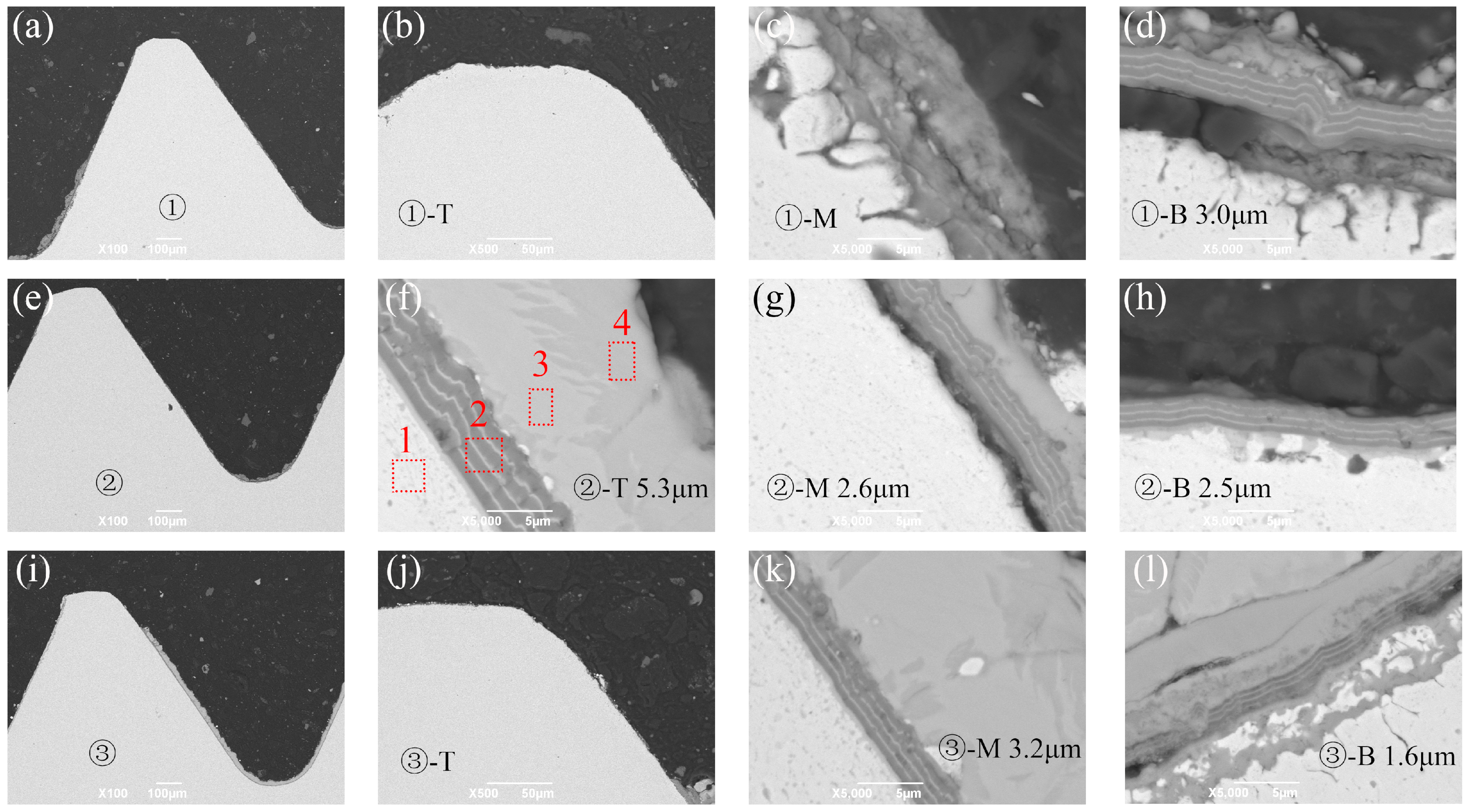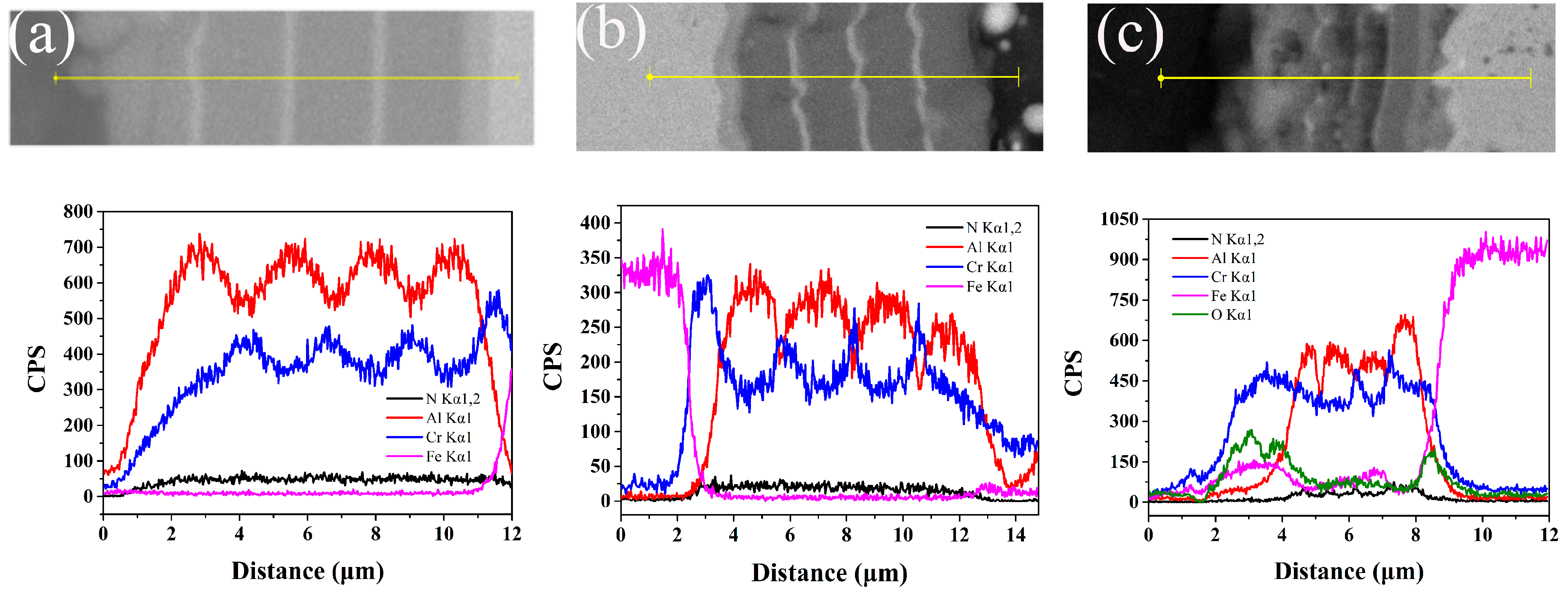Preparation, Characterization, and High-Temperature Anti-Seizing Application of CrAlN-Based Gradient Multilayer Coatings
Abstract
:1. Introduction
2. Experimental
3. Results and Discussion
3.1. Morphology, Structure, and Mechanical Properties
3.2. Tribological Performance
3.3. Characterization of Coated Screws
3.4. Simulation Service Analysis of Screws
4. Conclusions
Author Contributions
Funding
Data Availability Statement
Conflicts of Interest
References
- Croccolo, D.; De Agostinis, M.; Fini, S.; Olmi, G. Tribological properties of bolts depending on different screw coatings and lubrications: An experimental study. Tribol. Int. 2017, 107, 199–205. [Google Scholar] [CrossRef]
- Park, C.; Kim, H.-S.; Chung, W.-H.; Kim, J.-H. Validation of cyanide copper electrodeposited layer on test coupons for anti-seizing and outgassing in Tokamak vacuum vessel. Fusion Eng. Des. 2019, 146, 2598–2602. [Google Scholar] [CrossRef]
- Kwon, J.-D.; Lee, S.; Lee, K.-H.; Rha, J.-J.; Nan, K.-S.; Kwon, S.-H. Lubrication properties of silver-palladium alloy prepared by ion plating method for high temperature stud bolt. Trans. Nonferrous Met. Soc. China 2011, 21, S12–S16. [Google Scholar] [CrossRef]
- Kwon, J.-D.; Lee, S.-H.; Lee, K.-H.; Rha, J.-J.; Nam, K.-S.; Choi, S.-H.; Lee, D.-M.; Kim, D.-I. Silver-palladium alloy deposited by DC magnetron sputtering method as lubricant for high temperature application. Trans. Nonferrous Met. Soc. China 2009, 19, 1001–1004. [Google Scholar] [CrossRef]
- Jojith, R.; Sam, M.; Radhika, N. Recent advances in tribological behavior of functionally graded composites: A review. Eng. Sci. Technol. Int. J. 2022, 25, 100999. [Google Scholar] [CrossRef]
- Kakulite, K.K.; Kandasubramanian, B. Rudiment of ‘galling: Tribological phenomenon’ for engineering components in aggregate with the advancement in functioning of the anti-galling coatings. Surf. Interfaces 2019, 17, 100383. [Google Scholar] [CrossRef]
- Thompson, V.; Eaton, R.; Raffray, R.; Egorov, K. Properties of low friction anti-seize coatings for fusion applications. Fusion Eng. Des. 2019, 146, 345–348. [Google Scholar] [CrossRef]
- Kashyap, A.; Harsha, A.P.; Kondaiah, P.; Barshilia, H.C. Study on galling behaviour of HiPIMS deposited Mo/DLC multilayer coatings at ambient and elevated temperature. Wear 2022, 498–499, 204327. [Google Scholar] [CrossRef]
- Sathish, M.; Radhika, N.; Saleh, B. A critical review on functionally graded coatings: Methods, properties, and challenges. Compos. Part B Eng. 2021, 225, 109278. [Google Scholar] [CrossRef]
- Akrami, S.; Edalati, P.; Fuji, M.; Edalati, K. High-entropy ceramics: Review of principles, production and applications. Mater. Sci. Eng. R Rep. 2021, 146, 100644. [Google Scholar] [CrossRef]
- Bai, H.; Zhong, L.; Kang, L.; Liu, J.; Zhuang, W.; Lv, Z.; Xu, Y. A review on wear-resistant coating with high hardness and high toughness on the surface of titanium alloy. J. Alloys Compd. 2021, 882, 160645. [Google Scholar] [CrossRef]
- Krella, A. Resistance of PVD Coatings to Erosive and Wear Processes: A Review. Coatings 2020, 10, 921. [Google Scholar] [CrossRef]
- Wang, D.; Lin, S.-S.; Tian, T.; Liu, M.-X.; Chang, G.-R.; Dong, D.; Shi, J.; Dai, M.-J.; Jiang, B.-L.; Zhou, K.-s. Sand erosion and crack propagation mechanism of Cr/CrN/Cr/CrAlN multilayer coating. Ceram. Int. 2022, 48, 24638–24648. [Google Scholar] [CrossRef]
- Ruan, H.; Wang, Z.; Wang, L.; Sun, L.; Peng, H.; Ke, P.; Wang, A. Designed Ti/TiN sub-layers suppressing the crack and erosion of TiAlN coatings. Surf. Coat. Technol. 2022, 438, 128419. [Google Scholar] [CrossRef]
- Zhang, M.; Li, Y.; Feng, Y.; Xin, L.; Niu, Y.; Su, J.; Zhu, S.; Wang, F. Studies on different oxidation behaviors of TiAlN on titanium alloy and stainless steel under thermal cycling. Corros. Sci. 2021, 192, 109865. [Google Scholar] [CrossRef]
- He, J.; Lan, X.; Liu, Z.; Jiao, D.; Zhong, X.; Cheng, Y.; Tang, C.; Qiu, W. Modification of Cr/CrN composite structure by Fe addition and its effect on decorative performance and corrosion resistance. Ceram. Int. 2021, 47, 23888–23894. [Google Scholar] [CrossRef]
- Liew, W.Y.H.; Lim, H.P.; Melvin, G.J.H.; Dayou, J.; Jiang, Z.-T. Thermal stability, mechanical properties, and tribological performance of TiAlXN coatings: Understanding the effects of alloying additions. J. Mater. Res. Technol. 2022, 17, 961–1012. [Google Scholar] [CrossRef]
- Bonu, V.; Jeevitha, M.; Praveen Kumar, V.; Srinivas, G.; Siju; Barshilia, H.C. Solid particle erosion and corrosion resistance performance of nanolayered multilayered Ti/TiN and TiAl/TiAlN coatings deposited on Ti6Al4V substrates. Surf. Coat. Technol. 2020, 387, 125531. [Google Scholar] [CrossRef]
- Guo, H.; Sun, Q.; Zhou, D.; Yu, M.; Wang, Y.; Wang, Q.; Li, X. Erosion behavior of CrN, CrAlN and CrAlN/CrN multilayer coatings deposited on Ti6Al4V. Surf. Coat. Technol. 2022, 437, 128284. [Google Scholar] [CrossRef]
- Li, C.; Wang, L.; Shang, L.; Cao, X.; Zhang, G.; Yu, Y.; Li, W.; Zhang, S.; Hu, H. Mechanical and high-temperature tribological properties of CrAlN/TiSiN multilayer coating deposited by PVD. Ceram. Int. 2021, 47, 29285–29294. [Google Scholar] [CrossRef]
- Guo, C.Q.; Pei, Z.L.; Fan, D.; Liu, R.D.; Gong, J.; Sun, C. Predicting multilayer film’s residual stress from its monolayers. Mater. Des. 2016, 110, 858–864. [Google Scholar] [CrossRef]
- Reiter, A.E.; Derflinger, V.H.; Hanselmann, B.; Bachmann, T.; Sartory, B. Investigation of the properties of Al1−xCrxN coatings prepared by cathodic arc evaporation. Surf. Coat. Technol. 2005, 200, 2114–2122. [Google Scholar] [CrossRef]
- Zhang, X.; Tian, X.; Gong, C.; Liu, X.; Li, J.; Zhu, J.; Lin, H. Effect of plasma nitriding ion current density on tribological properties of composite CrAlN coatings. Ceram. Int. 2022, 48, 3954–3962. [Google Scholar] [CrossRef]
- Al-Asadi, M.M.; Al-Tameemi, H.A. A review of tribological properties and deposition methods for selected hard protective coatings. Tribol. Int. 2022, 176, 107919. [Google Scholar] [CrossRef]
















| Metal Base Cr | Buffer CrN | Functional CrN | Functional CrAl | Functional CrAlN | |
|---|---|---|---|---|---|
| Ar flow (sccm) | 100~200 | 30~70 | 30~70 | 100~200 | |
| N2 flow (sccm) | / | 200~600 | 200~600 | 700~1000 | |
| Deposition pressure (Pa) | 0.3~0.5 | 0.6~1.5 | 0.6~1.5 | 0.3~0.5 | 1.5~3.5 |
| Cr current (A) | 90~120 | 90~120 | 90~120 | 90~120 | 90~120 |
| CrAl current (A) | / | ||||
| Bia (V) | −200~−450 | −100~−250 | −100~−250 | −100~−200 | −60~−150 |
| Time (min) | 5~10 | 15~25 | 5~10 | 5~10 | 40~60 |
| Cycle (time) | / | / | 3 | 3 | 4 |
| Samples | Roughness (Ra)/μm | Nano-Hardness/GPa | Elastic Modulus/GPa | Adhesion Strength/N | Residual Stress/GPa |
|---|---|---|---|---|---|
| 1-CrN/CrAlN | 0.15~0.18 | 22.8 ± 2.7 | 344.7 ± 30.9 | 29.0 ± 1.0 | −0.41 |
| 2-CrAl/CrAlN | 0.34~0.37 | 24.1 ± 0.3 | 354.2 ± 22.2 | 22.0 ± 0.8 | −0.41 |
| 3-CrAlN | 0.31~0.38 | 22.4 ± 2.9 | 358.1 ± 35.0 | 29.6 ± 0.2 | −0.37 |
| Sample | Marked Label | N | O | Al | Si | Cr | Total |
|---|---|---|---|---|---|---|---|
| 1-CrN/CrAlN | 1 | 50.74 | 5.22 | 28.87 | 0.12 | 15.05 | 100.00 |
| 2 | 54.43 | / | 24.76 | / | 20.81 | 100.00 | |
| 2-CrAl/CrAlN | 3 | 48.91 | 8.39 | 28.02 | 0.49 | 14.21 | 100.00 |
| 4 | 51.64 | 1.49 | 30.94 | / | 15.93 | 100.00 | |
| 5 | 41.14 | 10.32 | 31.86 | 0.44 | 16.24 | 100.00 |
| Marked Label | N | O | Al | Cr | Fe | Ni | Cu | Total |
|---|---|---|---|---|---|---|---|---|
| 1 | / | / | / | 22.00 | 68.14 | 7.54 | 2.33 | 100.00 |
| 2 | 52.40 | 5.16 | 24.09 | 17.20 | 1.14 | / | / | 100.00 |
| 3 | / | 59.87 | / | 0.69 | 39.43 | / | / | 100.00 |
| 4 | / | 64.52 | / | 0.31 | 35.17 | / | / | 100.00 |
| 5 | / | 58.48 | 6.01 | 8.48 | 27.03 | / | / | 100.00 |
| 6 | 58.81 | 6.71 | 21.69 | 11.15 | 1.64 | / | / | 100.00 |
Disclaimer/Publisher’s Note: The statements, opinions and data contained in all publications are solely those of the individual author(s) and contributor(s) and not of MDPI and/or the editor(s). MDPI and/or the editor(s) disclaim responsibility for any injury to people or property resulting from any ideas, methods, instructions or products referred to in the content. |
© 2024 by the authors. Licensee MDPI, Basel, Switzerland. This article is an open access article distributed under the terms and conditions of the Creative Commons Attribution (CC BY) license (https://creativecommons.org/licenses/by/4.0/).
Share and Cite
Tang, C.; Li, D.; Yuan, X.; Wang, W.; Guo, X.; Fang, Y.; Gong, X.; Li, Q. Preparation, Characterization, and High-Temperature Anti-Seizing Application of CrAlN-Based Gradient Multilayer Coatings. Crystals 2024, 14, 509. https://doi.org/10.3390/cryst14060509
Tang C, Li D, Yuan X, Wang W, Guo X, Fang Y, Gong X, Li Q. Preparation, Characterization, and High-Temperature Anti-Seizing Application of CrAlN-Based Gradient Multilayer Coatings. Crystals. 2024; 14(6):509. https://doi.org/10.3390/cryst14060509
Chicago/Turabian StyleTang, Chunmei, Dingjun Li, Xiaohu Yuan, Wei Wang, Xianping Guo, Yu Fang, Xiufang Gong, and Quande Li. 2024. "Preparation, Characterization, and High-Temperature Anti-Seizing Application of CrAlN-Based Gradient Multilayer Coatings" Crystals 14, no. 6: 509. https://doi.org/10.3390/cryst14060509
APA StyleTang, C., Li, D., Yuan, X., Wang, W., Guo, X., Fang, Y., Gong, X., & Li, Q. (2024). Preparation, Characterization, and High-Temperature Anti-Seizing Application of CrAlN-Based Gradient Multilayer Coatings. Crystals, 14(6), 509. https://doi.org/10.3390/cryst14060509






